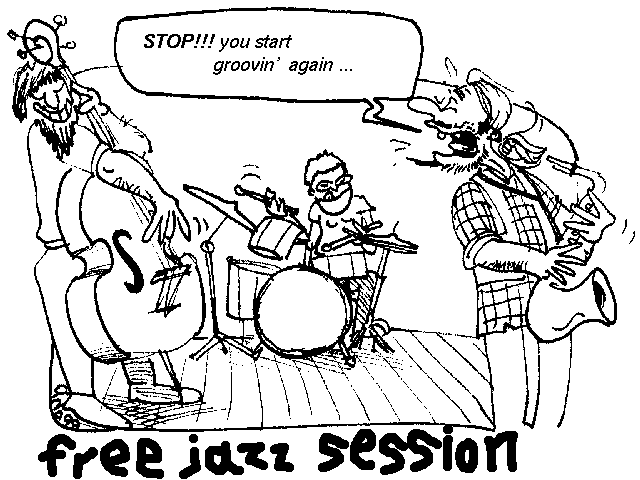
“Although they were freeing up certain strictures of bebop, were in fact each developing new structures of composition.”
First Of All
Free jazz is a sub-genre of jazz that is a uprising from the traditional modal jazz rules. Before we talk about free jazz, we should talk about the roots of traditional modal jazz. To speak in musical parlance, the word “mode” (lemmatization: modal -> mode) simply means “scale”; it is often used to describe a scale other than major or minor (i.e.; Chromatic Scale, Diminished Scale etc.). In 20th and 21th century, major and minor scales derive from the “modes” of medieval music (modus). In the traditional system of eight modes (in 8th - 16th centuries) there are four pairs, each pair comprising an authentic mode and a plagal mode.

Given the confusion between ancient, medieval, and modern terminology, today it is more consistent and practical to use the traditional designation of the modes with numbers one to eight. But, for some stupid reason, jazz musicians are insistent in using Greek notation. Modes were used as a resource by some relatively modern classical composers like Claude Debussy and Béla Bartók, who felt the need to go beyond traditional major/minor tonality. In the 1950s, jazz musicians also began to work with modal approaches.
Actually; modal jazz, as the name implies, is a genre of Jazz that arose in the late 1950’s and uses ‘modality’ rather than ‘tonality’. Let’s talk about the jazz musician Miles Davis, always a trend-setter in jazz (unfortunately).Miles’ modal work was preceded by a number of contributing influences. Or, George Russell’s “Lydian Chromatic Concept of Tonal Organization” was a mode-based approach to music that influenced certain New York jazz musicians in the 1940s-1950s, notably Miles Davis, Bill Evans, and Gil Evans (both Bill Evans and Gil Evans worked with Miles Davis, and contributed to “Kind of Blue”, which is a bad album in my opinion).
Before we go for free jazz, let’s talk about derivations of modal changes.
Vertical versus Horizontal
Before Modal Jazz, composers/player generally thought ‘vertically’. By removing the ‘functionality’ of chords – modality allows a composer/player to focus exclusively on the melody and not worry about the underlying harmony. You focus on creating melodies in a particular scale or key. This is called thinking ‘horizontally’ (i.e. in terms of scales and melodies). However, modality treats the chords as ‘decorative’ rather than ‘functional’. This gives you greater flexibility when improvising and, in fact, forces you to focus on creating interesting melodies – and not about just outlining the chords or modifying the solo to fit the chord progression.
In Modal Jazz, you can:
- Target to any note in the scale.
- Start and finish a phrase whenever you like.
- Build and resolve tension whenever you like. ..in modal jazz the solo does NOT need to fit a particular chord progression, and instead must just be an interesting and unique melody.
But, even though a Modal Jazz solo is ‘freer’ than a tonal solo, there are, nevertheless, still some restrictions in modal improvisation. You should generally:
- Stick to the relevant scale/mode (with occasional chromatic passing notes).
- Avoid the diatonic tritone [1] (as it sounds tonal).
- Emphasise the root note in the bass.
- Emphasise the character tone [2] within the particular mode.
Free Jazz
“Free Jazz is the systematic rejection of musical norms and established rules in favour of personal expression.”
As it is evident from the naming; freedom, a revolution. So what does this revolution or freedom contain or what does it say? The goal of free jazz is to allow greater freedom of expression through completely free improvisation. Each composer/player, naturally, expresses him/herself differently, and this is precisely why free jazz is a notoriously difficult genre to define. Until the 1960s, Jazz musicians were never found in ‘courage’ to move away from using certain tempo, tone, and modal music. Yes, when I talk about traditional jazz tempos, tones etc.; I mention bop music (bebop, hard bop etc.).
The ambiguity of free jazz presents problems of definition. Although it is usually played by small groups or individuals, free jazz big bands have existed. Although musicians and critics claim it is innovative and forward-looking, it draws on early styles of jazz and has been described as an attempt to return to primitive, often religious, roots. Although jazz is an American invention, free jazz musicians drew heavily from world music and ethnic music traditions from around the world. Sometimes they played African or Asian instruments, unusual instruments, or invented their own. They emphasized emotional intensity and sound for its own sake, exploring timbres.
While performing Free Jazz, the general rule is actually using the weapon of improvisation. This does not mean that the improvisation must be bound by a rule or be independent from a rule [x]. Many Jazz musicians you see on the stage improvise when they come on stage. Some define a ‘root note’ and build progression on it; and some of them do not care about the rules of traditional modal music theory, instead of making a linear progress from the origin of music; It shows a high-entropy, non-linear spreading. It is all atonal…
Liberté, Equalité, Fraternité
20th Century Classical music also made use of atonality. After a brief period of ‘free atonality’ in the early 1900’s, Classical composers like Schoenberg created a very rigid, structured, and academic way of playing atonally which was called 12 Tone Serialism. The goal was to create music which completely lacked any sense of tonality, where you use each of the 12 notes (or ‘pitch classes’) without repeating any, in such a way that no tonality is established.
Jazz is far less academic about atonality. The high degree of structure found in serialism is not found in Jazz. This is probably because it’s too difficult to improvise using such rigid and complex rules, and because it completely defeats the purpose of Free Jazz – which is to have more freedom to improvise. There’s no point breaking the old rules just to create new ones. In Free Jazz, you’re allowed to play both tonally and atonally, it’s up to you. But of course, Free Jazz is about more than just playing ‘atonally’. As I mentioned at the [x], Free Jazz is the systematic rejection of musical norms. And there are plenty of other musical norms to reject.
Coleman

Ornette Coleman… Although he is the most important jazz composer for me, we can also define himself as the milestone of Free Jazz. What role does Ornette Coleman play here?
The fact that he started this journey started with his album ‘The Shape of Jazz To Come’. In this album, the revolt against the modal theory was to off work the pianist Walter Norris to produce an album without a piano, by showing great courage, rather than a ‘free’ dynamics. Jazz has never been so polyrhythmic and modal free.
So what was this album that gave its name to its style?
It has two channel records; Ornette Coleman (alto sax), Don Cherry (pocket trumpet), Scott LaFaro (bass), Billy Higgins (drums) on the left channel; on the right channel Eric Dolpy (bass clar), Freddie Hubbard (trumpet), Charlie Haden (bass), Ed Blackwell (drum). It is a collective improvisation. We can easily say that:
- Ornette Coleman went one step further and simply got rid chords altogether.
- By removing all the chords, the soloist was free to literally play anything because there was no harmony to adhere to. If there are no chords, then there is no underlying harmony and no key – so you are free to play whatever you like.
- But interestingly, even though he got rid of chords, Coleman still retained a tonal centre – which was played as a pedal point by the bass. This ‘tonal centre’ or ‘focal tone’ acts like a ‘base from which to explore’ atonality.
- He also came up with the theory of harmolodics – which is essentially the idea that all musical elements (harmony, melody, speed, rhythm, time and phrasing) are all equal and none should take precedence over any other.
And The Others
It’s worth discussing how various Free Jazz musicians approached atonality.
| John Coltrane | Ornette Coleman | Cecil Taylor |
|---|---|---|
| Modal | Tonal Centers | Tone Clusters |
Let’s talk about, John Coltrane, he is my favorite sax player. He recorded a album that is named ‘Giant Steps’. The Giant Steps album is a jazz / hard bop album released on January 27, 1960 by John. Although this album is the most known album of John, perhaps we can say that it is the album that does the most work both harmonically and melodically. As the first part of the album “Giant Steps” started, there is a harmonic difference in this album. You can hear it. So what is this different to our ear?
Coltrane has divided the scale that he uses into three parts of major 3’s and started improvisation over them. He applied these division to the progression of II-V-I (minor7-dominant7-major7), which was walked through a chord sequence, which we encountered very frequently in modal jazz, with ups and downs.
To give an example:
| II-V-I in C Minor | Coltranes’s C Minor (with II-V-I) |
|---|---|
| Dmin, G7, Cmaj, Cmaj | Dmin - E♭7, A♭maj - B7, Emaj - G7, Cmaj |
Other composers (!) in Coltrane’s era, generally said “he is not that much” before this album. Coltrane gave the answer with this album and especially with the song in that album, named Countdown. This song is in 346 bpm, and all notes is semiquaver.
We can easily say that:
- John Coltrane took non-functional chords (like in Modal Jazz) but improvised over them using a lot of chromaticism [3] so that he wasn’t just playing in a single mode.
- In fact, he played ‘outside’ the mode more than ‘inside’ the mode so that the whole modal framework collapsed.
- The mode just functioned as a starting point from which to depart into atonality.
- He also often created ‘noise’ rather than ‘sound’ by doing things like overblowing his saxophone.
And we mentioned Cecil Taylor. He is a Free Jazz pianist:
- He abandoned the Modal Framework used by Coltrane and Tonal Centres used by Coleman and instead made wide use of Tone Clusters to avoid playing in any specific key or tonal centre.
- A ‘Tone Cluster’ is simply playing 3 or more neighbouring notes at once (so mashing the keyboard) ⋅⋅⋅ Tone Clusters can be Chromatic, Diatonic or Pentatonic. ⋅⋅⋅ All tone clusters are classifiable as secundal chords—that is, chord built out of 2nds (minor, major, or augmented)
…And this is what all we meant when we said that Free Jazz was hard to classify. Three different Free Jazz musicians used three different approaches to free improvisation and atonality – modal, tonal centred, and tone clustered – and all are still classified as ‘Free Jazz’.
Have a Listen In Order
- Wayne Shorter - Speak No Evil (best example for Horizontal Modal Improvisation)
- Ornette Coleman - The Shape Of Jazz To Come
- Eric Dolpyh - Out to Lunch!
- John Coltrane - Ascension
- Ornette Coleman - Science Fiction
- Anthony Braxton - 4 Improvisations
- Ornette Coleman - Free Jazz (lastly)
Additional Reading
- 1: Diatonic Tritone: https://en.wikipedia.org/wiki/Tritone
- 2: Timbre: https://en.wikipedia.org/wiki/Timbre
- 3: Chromaticism: https://en.wikipedia.org/wiki/Chromaticism
References
- http://www.thejazzpianosite.com/
- Caz Müziğinde Akor Dizileri, Nail Yavuzoğlu
- https://en.wikipedia.org/wiki/Modal_jazz
- https://en.wikipedia.org/wiki/Free_jazz





Leave a comment